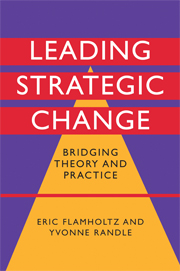Book contents
- Frontmatter
- Contents
- List of exhibits
- Preface
- Acknowledgments
- Part I An integrative framework for leading strategic and organizational change
- Part II Leading strategic change in actual organizations
- 4 Leading strategic and organizational change at Countrywide Financial Corporation
- 5 Leading change at Starbucks Coffee Company
- 6 Strategic marketing through HR interventions: a case study of Indian Oil Corporation
- 7 The evolution of Stan Tashman and Associates
- 8 Leading strategic and organizational change at IndyMac Bank
- 9 Leading strategic and organizational change at Infogix
- 10 Leading strategic and organizational change: the transformation of structure at Pardee Homes
- 11 Leading strategic and organizational change at Tata Steel: the role of culture
- 12 Leading strategic and organizational change at Westfield: transformation to a global enterprise
- Part III Leading strategic change: lessons learned from practice
- Appendix: References for further reading on leading change
- Index
12 - Leading strategic and organizational change at Westfield: transformation to a global enterprise
from Part II - Leading strategic change in actual organizations
Published online by Cambridge University Press: 22 September 2009
- Frontmatter
- Contents
- List of exhibits
- Preface
- Acknowledgments
- Part I An integrative framework for leading strategic and organizational change
- Part II Leading strategic change in actual organizations
- 4 Leading strategic and organizational change at Countrywide Financial Corporation
- 5 Leading change at Starbucks Coffee Company
- 6 Strategic marketing through HR interventions: a case study of Indian Oil Corporation
- 7 The evolution of Stan Tashman and Associates
- 8 Leading strategic and organizational change at IndyMac Bank
- 9 Leading strategic and organizational change at Infogix
- 10 Leading strategic and organizational change: the transformation of structure at Pardee Homes
- 11 Leading strategic and organizational change at Tata Steel: the role of culture
- 12 Leading strategic and organizational change at Westfield: transformation to a global enterprise
- Part III Leading strategic change: lessons learned from practice
- Appendix: References for further reading on leading change
- Index
Summary
Introduction
The Westfield Group is an Australian listed public company that owns, develops, renovates, and manages shopping centers in Australia, New Zealand, the United States, and the United Kingdom. It is an example of a company that has transformed itself from an Australian company into a truly global business.
In late 2001 Frank Lowy, Executive Chairman and co-founder of Westfield, and his son Peter Lowy, Joint Group Managing Director, were sitting in the Amstel Hotel in Amsterdam discussing the details of Westfield's bid to acquire Rodamco NV, a Dutch company listed on the Amsterdam Stock Exchange that owned North American real estate assets. As they reflected on the impending deal – an Australian company investing Australian dollars to buy the stock of a European company in euros in order to own shopping mall assets valued in US dollars – they had an epiphany. They realized that Westfield had become a global enterprise and that the commercial real estate industry was about to follow suit. This insight prompted Peter, Frank, and other company leaders to recognize that Westfield needed to begin to think of itself as a global business rather than as a purely Australian business.
This case provides background on the origins of Westfield, and then relates how company leaders managed growth, development, and globalization through multiple phases of expansion and diversification, and describes the lessons learned in each phase. As the case ends, the company is entering a new phase of operating as a global company.
- Type
- Chapter
- Information
- Leading Strategic ChangeBridging Theory and Practice, pp. 205 - 226Publisher: Cambridge University PressPrint publication year: 2008



